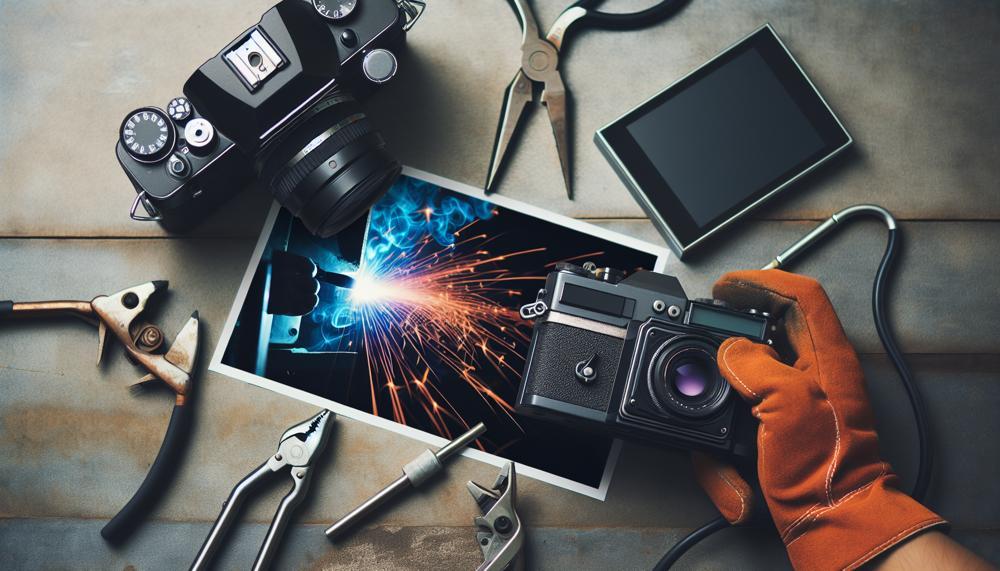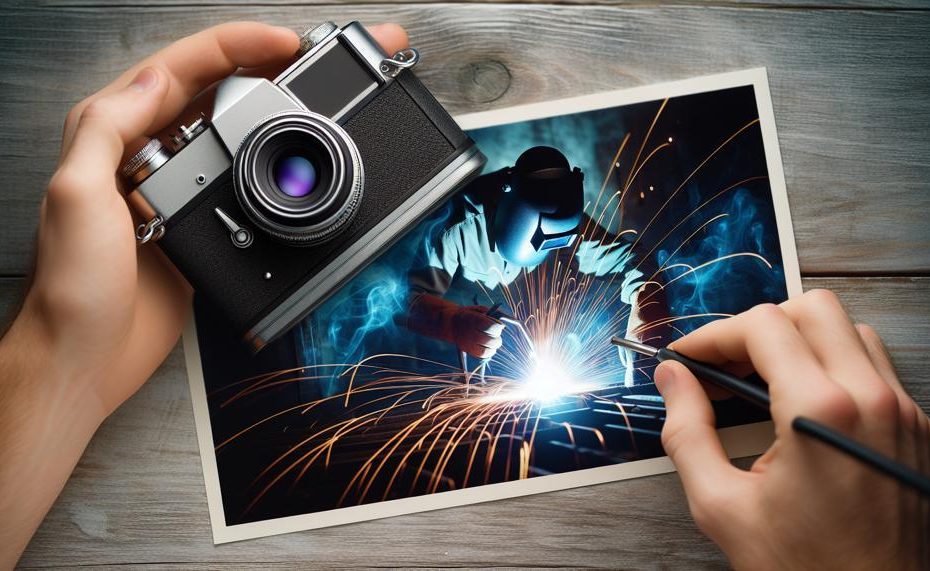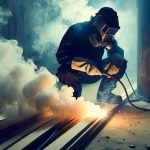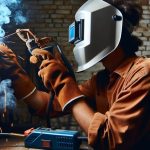Imagine being able to witness the mesmerizing dance of a welding arc up close and personal, without the risk of being burned or blinded.
Thanks to modern technology, this is now possible through the lens of a camera. As a welder, you know that the welding arc is where the magic happens – where two separate pieces of metal are fused together to create something new and strong.
But have you ever wondered what it would be like to view this process from a different perspective? In this blog post, we’ll explore the question: can a welding arc truly be captured through a camera?
No, you cannot look at a welding arc through a camera. The brightness of the arc is much higher than most video cameras can capture. The image will be overexposed and blown out, and the camera and display will be saturated. The camera may also be damaged by splatter or sparks.
Let’s dive in and discover how a simple camera can revolutionize your welding experience.
Contents
- 1 What is the best way to record welding?
- 2 How do you film welding?
- 3 Can you record welding with your phone?
- 4 Can you record welding with a GoPro?
- 5 Can welding damage your camera?
- 6 Can the arc’s bright light damage your camera sensor?
- 7 How to protect your camera when you film welding?
- 8 Can watching a video of welding hurt your eyes?
- 9 Conclusion
What is the best way to record welding?
It’s crucial to use the right equipment and take necessary precautions to ensure safety and quality footage. Professional welding cameras are specifically designed for this purpose, offering features such as real-time inspection, high-quality footage, portability, zoom functionality, and industrial-grade durability
However, it’s not recommended to use smartphones or GoPros for filming welding due to potential hazards from intense light and heat. If used, precautions must be taken, such as using a filter and avoiding close-up shots.
It’s also essential to protect the camera’s sensor from potential damage caused by overheating or exposure to UV rays. While watching welding videos won’t harm your eyes directly, proper protective gear must always be worn during actual welding processes.
Opting for a professional welding camera is the best way to accurately capture welding arcs. Not only does it provide a safe and effective way to monitor and improve welding processes, but it also ensures high-quality footage.
How do you film welding?
When it comes to capturing welding footage, precision is key. To ensure high-quality footage, you’ll need a high dynamic range camera and a sturdy tripod. But equipment isn’t the only factor to consider.
Proper positioning techniques, exposure and shutter speed control, white balance adjustment, and adequate lighting are also crucial for accurate filming.
Welding is not only a bright and intense process, but it also produces a lot of heat and sparks. This can be dangerous for both the equipment and the operator. That’s why a high dynamic range camera is essential. It allows for a wider range of light to be captured, resulting in more accurate footage without compromising safety.
Additionally, using a tripod ensures that the camera stays steady during filming. This is especially important when capturing close-up shots of the welding process. But even with the right equipment, proper techniques are still necessary to get the best footage.
Exposure and shutter speed control are crucial for capturing the bright flashes of light produced during welding. These settings need to be adjusted to properly capture the intensity of the welding process without overexposure or underexposure.
White balance adjustment is also important as it ensures that the colors in the footage are accurate and not distorted by the bright light produced during welding. And last but not least, proper lighting is crucial for clear footage. Without adequate lighting, it can be challenging to capture all the details of the welding process accurately.
Can you record welding with your phone?
Absolutely, but there are important factors to consider in order to produce a clear and accurate video. Here are some tips to help you achieve the best footage possible:
- Use a filter: Welding emits intense light and heat that can potentially damage your phone’s camera lens. To protect it, use a welding filter or cover when recording.
- Avoid close-up shots: The powerful light and heat from welding can also harm your phone’s camera sensors, resulting in distorted or low-quality videos. It’s best to maintain a safe distance and avoid close-up shots.
- Use a stable surface or tripod: Shaky footage can be difficult to watch and may not accurately capture the welding process. Utilize a sturdy tripod or place your phone on a stable surface while recording.
- Consider using a GoPro: While smartphones can capture decent footage, GoPros are specifically designed for action shots and have superior lenses that can withstand the intense light and heat of welding.
- Properly maintain your camera sensors: Over time, the intense light and heat from welding can cause damage to your camera’s sensors, leading to poor image quality. Regularly cleaning and replacing damaged sensors is crucial for optimal footage.

Can you record welding with a GoPro?
The answer is yes, it is possible to record welding with a GoPro camera. However, there are certain challenges that need to be addressed in order to obtain high-quality footage.
Using a GoPro to film welding can be challenging due to the intense light and heat produced during the process. This compact and versatile camera has gained popularity for its durability and wide range of features, making it a popular choice for recording various activities and events.
However, the camera’s auto-adjusting exposure feature can cause difficulties when capturing clear images in a welding environment. The intense light and heat can result in overexposure or underexposure, making it difficult to obtain quality footage.
To overcome this challenge, experts recommend using neutral density (ND) filters or welding filters. These filters help darken the light and prevent strobing effects in the footage, resulting in clearer images. Another helpful tip is to shoot at the highest resolution possible and zoom in during editing. This technique can significantly improve the clarity and visibility of details in the footage.
Another important aspect to consider when recording welding with a GoPro is protecting the camera from physical damage. The intense heat generated during welding can damage the camera’s sensors if placed too close without proper protection. It is recommended to use a stable surface or tripod and to avoid placing the camera too close to the welding area.
While using a GoPro can result in satisfactory footage, it may not be ideal for professional or detailed recordings of welding.
For better quality footage and enhanced visibility of details, it is recommended to use a dedicated weld camera.
Can welding damage your camera?
Welding can be a risky activity for cameras due to the intense light, heat, and flying debris that it produces. However, with proper precautions and equipment, cameras can be protected from these hazards.
When it comes to welding, there are three main hazards that can damage cameras: intense light, heat, and flying debris. These hazards can potentially cause significant harm to the camera’s delicate components, such as the sensor and lens.
- Firstly, welding produces bright light that can potentially damage the camera’s sensor. This is especially true for DSLR cameras with larger sensors. To protect the camera’s sensor from this intense light, it is recommended to use a filter as a cover for the lens when filming welding. This will help reduce the amount of light entering the camera and prevent any potential damage.
- Secondly, the high temperatures generated during welding can also damage cameras. The heat can melt or warp the delicate components inside the camera. To safeguard against this heat, it is important to keep the camera at a safe distance from the welding arc. Additionally, using a heat-resistant cover or shield can also provide added protection.
- Lastly, welding produces sparks and debris that can potentially damage the camera’s lens or other parts. To prevent this from happening, it is recommended to use a protective cover or shield for the camera. This will help reduce the chances of any debris coming in contact with the camera.
Can the arc’s bright light damage your camera sensor?
There are important factors to consider in order to guarantee the safety of both the camera and its sensor.
The type of camera being used is a crucial factor to keep in mind. While smartphones are convenient and easily accessible, they are not built to withstand the harsh conditions of welding.
They often lack necessary filters and protective covers for the lens and sensor, making them vulnerable to intense light and heat. It is highly recommended to use specialized welding cameras designed specifically for this purpose.
Professional welding cameras offer a range of benefits such as real-time inspection, high-quality photos and videos, portability, quick setup time, and zoom functionality. These cameras also come equipped with built-in filters that offer protection from harmful UV rays and intense light.
They are built to withstand the extreme conditions of welding while providing a clear and detailed view of the process.
How to protect your camera when you film welding?
When capturing welding scenes, it is crucial to safeguard your camera from the intense light and heat emitted during the process. This can be achieved by using specialized welding cameras or regular cameras with protective measures in place. Here are some strategies to protect your camera while filming welding scenes:
| Opt for a specialized welding camera: | Consider investing in a specialized welding camera designed to withstand the intense light emissions and provide high-quality footage. |
| Utilize a lens filter: | If using a regular camera, cover it with a lens filter to protect it from weld spatter and damage from the bright light. |
| Create a makeshift welding camera: | Align a regular camera with welder’s goggles to create a makeshift welding camera capable of withstanding the intense light and heat. |
| Choose an industrial-grade welding camera: | When using a professional welding camera, ensure it is industrial-grade and can function 24/7 in any environment. |
| Consider the purpose of filming: | Determine the reason for filming the welding process – for analysis, instruction, or client requests – to select the appropriate camera and features. |
By following these tips, you can effectively safeguard your camera while filming welding scenes and capture exceptional footage for analysis or instructional purposes.
Remember, investing in the right equipment is crucial when capturing high-quality footage in intense environments.
Whether you opt for specialized welding cameras or utilize protective measures with regular cameras, always prioritize safety and quality when documenting this process.
Can watching a video of welding hurt your eyes?
It’s a common question among beginners, and the answer is not as straightforward as you might think. While watching a video or looking directly at a welding arc through a camera without proper eye protection may not cause immediate harm, it’s still highly recommended to use specialized gear in real-life welding scenarios.
Welding helmets, lenses, goggles, and face shields are specifically designed to block out harmful UV rays and prevent potential eye injuries during welding.
But with the latest advancements in technology, there are now specialized cameras that allow welders to view the welding arc through a camera lens without putting themselves at risk. This method has several benefits for welders, including enhancing techniques and ensuring safety.
These specialized cameras are built to withstand high temperatures and intense light levels, making them ideal for capturing welding footage compared to regular smartphones that are not designed for this purpose.
Moreover, using cameras for monitoring welding processes remotely also has practical advantages. It provides operators with a safe distance from the intense light and heat emitted during welding, reducing the risk of injuries and associated costs.
Additionally, these cameras aid in quality assurance by capturing images of the weld as it is being created, ensuring accuracy and identifying potential issues.
Also Read: What Is 8010 G Welding Rod?
Conclusion
As we reach the end of our exploration into the question of whether a welding arc can be viewed through a camera, one thing is clear – technology has once again amazed us with its capabilities. Gone are the days of risking burns and blindness to witness the mesmerizing dance of a welding arc.
Thanks to specialized welding cameras, we can now get up close and personal with this process without any danger.
These cameras not only provide high-quality footage but also prioritize safety for welders by keeping them at a safe distance from the intense light and heat.
Moreover, they play a crucial role in quality assurance and technique improvement by capturing images of the weld as it is being created.
However, it’s important to remember that while watching welding videos or looking at an arc through a camera may not immediately harm your eyes, safety should always be a top priority. It’s essential to use specialized protective gear and equipment when working with welding arcs.





